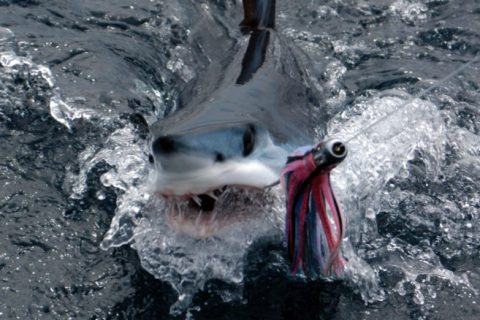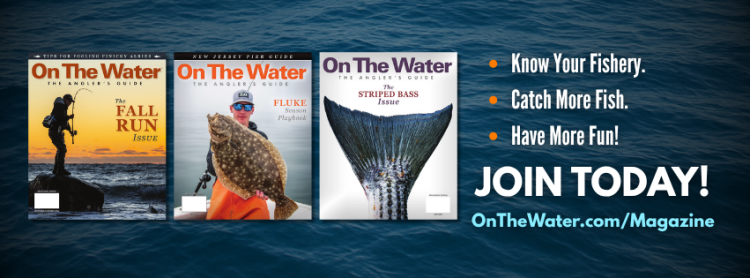Ditch the slick and drag lures to catch more makos and threshers.
My first taste of shark fishing came in the waters of the Mud Hole off the Jersey Coast just before I moved to California in 1981. Soon after buying my first boat on the left coast, I found out how incredibly abundant sharks were in the Eastern Pacific, and it didn’t take long for shark fishing to become my addiction. From 1987 to 1999, 80 percent of my fishing was shark fishing. I started fishing in shark tournaments, participated in a committee to set bag limits for recreational shark catches, and also participated in a shark tagging program.
It was during the tournaments of the late 1980s, that I was introduced to trolling for sharks. There were two or three teams that were always in the money or close to being in the money in those tournaments, and those teams were trolling.
Trolling For Sharks?
When most people think of shark fishing, they think of bait, balloons and chum slicks. While there is no doubt that this tactic works incredibly well, it is definitely not the only option as many East Coast fishermen believe.

Trolling is an often overlooked method of effectively targeting sharks. Here are just a few of the benefits of grabbing the downriggers instead of a chum bucket on your next shark mission.
• Cover More Water
On the East Coast, shark fishermen are lucky to be within reach of great underwater structure, steep drop-offs and swift currents. I’m going to assume most of you do your homework, pick a spot where you think sharks will be feeding, set up a chum slick, and wait for sharks to appear. If they don’t appear within an hour or two, you’re left with the choice of sticking it out in the location you chose and hoping they will appear, or breaking your slick and starting over in a new location. Chumming is very much a hit-or-miss affair. Even if you picked the best potential spot based on conditions, a chum slick can only cover so much water. Sharks arrive in a location either by following baitfish, or by being drawn in by temperature breaks or currents. They don’t just fall out of the sky onto a given spot. Trolling is a technique that allows you to more effectively cover a location by following the bait, working the temperature breaks and more effectively working around an entire piece of structure.
• Avoid The Pitfalls of Chumming
If there is no current or drift, the chum falls straight down and doesn’t attract anything. If there is too much wind or current, you drift off the spot too fast or you need to anchor in order to effectively hold your location. If you have an excited mako or thresher streaking around your boat, that anchor can go from a useful tool to a potential hazard that will cost you a shark. Although chumming is certainly an effective and time-tested method of sharking, it does have challenging aspects that can be avoided by trolling.
• Keep The Blue Dogs At Bay
When trolling, you should encounter far fewer blue sharks. I’ve only caught two blue sharks while trolling. Blue sharks are not as likely to chase and attack a trolled bait as the more desirable mako and thresher sharks, making you more capable of a species-specific approach. While chumming, we’ve caught up to 107 blue sharks in one day, and weeding through the blues can be a pain when chumming.
• Setting Up Your Trolling Pattern
Catching sharks on the troll is not as simple as setting out the lines and dragging lures over structure. You need an educated plan of attack to set up the most effective trolling pattern for sharks.

It’s been my experience that the ideal water temperature for mako sharks is 64 degrees. With that in mind, you will want to keep your deep lures either just above the thermocline, or just below it. My rule of thumb is that if the surface temperature is between 62 and 72 degrees, your best bet is to put the deep lures just above the thermocline and when surface temperatures are warmer than 72 degrees, put them just below the thermocline.
I run the second set of lures somewhere between the thermocline and the surface. I try to keep this second set of lures holding at a depth of about 10 feet.
You can also effectively fish lures on the surface for sharks.
Though I’ve caught sharks in all three positions, I must say that the deep lures have historically produced the best action.
Tooth-Tested Trolling Lures



Once you have an idea of how you’ll be setting up the trolling spread, you’ll need to figure out just what lures will get the most attention from sharks.
For the surface baits, skirted tuna and marlin lures in the larger sizes will do the trick. The difference between these lures and the ones you’re actually dragging for tuna or marlin will be your color selection. Color is an essential component in trolling lures for sharks. While talking to a researcher that studied shark eyes, I learned that sharks can discern colors extremely well. On bright, sunny days, you can throw away all color combinations except hot pink-and-white, red, orange, and yellow. When there is little or no light, switch to purple-and-black or green-and-black lures.
The best mid-depth lure I’ve found for shark trolling is the Bait-O-Matic from Strike Master. There are other similar trolling lures on the market, such as Ballyhoods. The same suggested colors for the surface lure will also work at the next level in the water column. It is important not to use planers or trolling weights because they may break or tangle during the fight. The aforementioned lures are designed to get lower in the water column while on the troll.
To run deep, near the thermocline, you’ll have to use downriggers with a downrigger ball or a Z-wing. This will get you to the propper depth, but there are drawbacks. Both makos and threshers have been known to attack downrigger balls. If a thresher ends up getting its tail wrapped in the cable, you could have a serious mess on your hands. An easy alternative is the Shark-O-Matic lure. This lure’s heavy, 16 oz.weight is perfect for slow trolling mako and thresher and gets the lure down deep where it belongs.
When using a downrigger, you can use any of the same lures you’ll be dragging on the surface. If the lures are set to run between 25 and 50 feet below the surface, then the same colors that work on the shallower baits will be just as effective at that depth. Below 50 feet, however, these lures become less effective, and I turn to lures that are green or blue.
At night or in low-light conditions, you should use darker colored lures. A researcher explained to me the reason why. Sharks have the ability to concentrate background light. So much so that it would be like a human looking at a full moon on a clear night. If you were to pass a light colored lure across the full moon, it would be difficult to see. But, if you were to hold a black lure up in front of the full moon, you would see it quite easily.
Rigging Up
When rigging up to troll for sharks be sure to use a multi-strand wire leader. Though the animals will usually strike the lure in such a way that the teeth are not likely to cut through the leader, the tough, abrasive skin of the sharks is the real enemy when fighting these fish. Therefore, you need a leader that is about as long as the shark. For makos, I use an 8- to 10-foot leader and for threshers I use a 12-to 15-foot leader.

I always like to attach bait to the lure. On the West Coast the primary bait is a dead, whole mackerel. On the East Coast, a mackerel or small bluefish will do the trick. Try to match your bait to whatever you suspect the sharks in the area are feeding on. When trolling inshore for threshers, try a whole bunker. Farther off in deeper water, squid may be a better option.
To rig these baits on the lures, use a double-hook rig. Put the hook closest to the lure through the bait’s mouth and rubber band the trailing hook somewhere near the bait’s tail to ensure that even short-striking sharks get hooked.
Where To Troll


Earlier, I mentioned the importance of temperature. Fishing water that is in the preferred temperature range for the sharks is critical to success, but it is not the only way you can use the water temperature to find fish. Temperature breaks create small currents which affect the feeding patterns of bait fish, which in turn attracts sharks. Some breaks are so obvious they can look like a line of slick water or a weed and debris line. Pass over them and see if the surface temperature changes. A temperature change of a half-degree can be enough to bring sharks in on the feed. Set up your troll along the edge of the break making sure to work both sides.
Water color boundaries can also signify the potential presence of sharks. Makos don’t like dirty water. Though they will enter dirty water if they have to, more often than not, the fish will avoid these areas. Clean, green water bordering on deep blue water is a great place to look for makos. Many fishermen targeting blues at the Barnegat Ridge have had makos attack their catch on the way in. This is because the ridge is one of those areas that seems to have a mix of the green inshore and blue offshore water.
Threshers don’t mind dirty water at all. You can find threshers as close as the surf break and as far out as the canyons. Often, these whip-tailed giants swim within 15 miles of the beach. In these inshore waters, the threshers are drawn to the abundant schools of bunker, and it’s not uncommon to find them crashing through these schools, sometimes clearing the water entirely in their pursuit of the baitfish.
One interesting fact to note about threshers is that at some point during their migration, they break up into gender-exclusive pods. Females are much larger than males. So if you find a large female, there may be more around.

Wrecks and mounds are good places to target as long as water color and temperatures meet the criteria mentioned earlier. If you’re going to fish canyons, try the edges first. If there is an upwelling, it will probably attract bait, which will ultimately attract sharks.
Follow the bluefish. A study showed that bluefish make up a tremendous portion of a mako shark’s diet. Therefore, in areas where you know there are bluefish, and the conditions fit those earlier described, it pays to take a few passes with the shark lures set out.
Speed
When trolling for sharks, a speed between of 2 and 4 knots is ideal. My most productive speed has been, more specifically, between 2½ and 3 knots. However, a Mako will eagerly hit faster-moving lures. I’ve actually had them eat marlin lures trolled at a speed of 8 knots. However, most of the rigs you’ll be deploying are meant to fish deeper in the water column, and won’t tolerate high-speed trolling.
Have A Plan
Today’s technology is great. Before you leave port, look at satellite surface water temperatures. If there are temperature breaks that cover structure, that should the first area you target. The beauty is that you are not committed to one spot for a length of time, as you are when setting up a chum slick. If you find a productive spot trolling, you always have the option to set up a chum slick once you locate it.
Trolling Etiquette
Extend the same courtesy to anglers that are chumming as you would under any other circumstances. Under no conditions should you motor through another fisherman’s slick. Give the non-trolling shark fishermen plenty of room to fish comfortably, as I am sure you would expect if you were setting up a slick.
Also, give a wide berth to boats that have hooked up a shark. Since your lines are covering a large part of the water column, a hooked shark could easily become entangled in your spread.
Keep in mind that these sharks are a finite resource. I urge you to tag and release as many sharks as you can, and to release all of the smaller ones to allow them to mature and reproduce.
Trolling for sharks has been an effective technique on the West Coast for years, and has slowly, but surely, been migrating east. Give it a try this summer, and you just might find yourself leaving the chum box at home on your next sharking mission.



Very interesting article. I shark fish a few times every season and look forward to trying these new to me techniques. Well written, thanks!